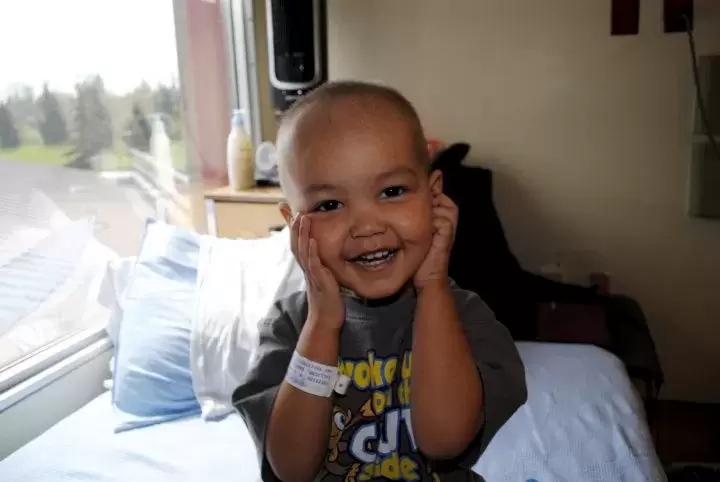Gabriel Callicum’s life is starting to get back to normal after he was diagnosed with leukemia Feb. 7, 2010. Today the three year old can go on play dates with little friends, comb the beach for rocks, or blow bubbles with his mom, Jeannine Lindsay, which he really loves to do.
This wasn’t the case only a few months ago. Back then, Gabriel’s immune system was so depleted from rounds of chemotherapy that Gabe and his mom just wouldn’t leave the house, afraid of the germs that would complicate his recovery.
Now, Gabriel can go on all the adventures his little heart desires, and his mom is looking forward to the day when she can say her baby boy is cancer free. He’ll be given the all clear in May 2013 if he remains in remission until that time. From now until then Jeannine will be watching her son closely for signs of relapse.
Adding to her worry is the fact that Gabriel has a genetic defect making him more prone to relapse. She’s watching to see if he breaks out in little spots on his body, or develops petechial hemorrhaging, tiny pinpoint red marks, in his eyes. His blood will be checked every two weeks to ensure his white blood count doesn’t spike, and his daily behavior will be monitored for signs that he is becoming lethargic.
That’s how the past 14 months began. The then-two-year-old began to sleep all the time, taking two to three long naps daily. His normally dark complexion turned pale. Gabe’s mom just knew something was very wrong, though at first she suspected that Gabe’s molars were coming in and that he had caught some kind of virus.
She took him to a walk-in clinic in Comox where she lives. That was at 3 p.m. on a Sunday. The doctor noticed some petechial hemorrhaging and hurried the little boy to get his blood work done. It was quickly discovered that Gabriel had leukemia, but what kind and how far it had progressed was still unknown.
Within the next two hours, Gabe was given a blood transfusion to get his platelets and red blood cells stabilized for a trip by helicopter to Children’s Hospital in Vancouver. His blood was depleted of oxygen, and his heart was two-times its normal size because of the work it needed to do to keep Gab’s body working.
“It was heartbreaking,” said Jeannine. “It was all that I could do to not (cry) all the way to Vancouver,” she said. But she had to stay strong and calm for her son. She said once Gabe had had the blood transfusion, he seemed as good as new, and was excited about his helicopter ride.
By Monday morning, however, he was in surgery and undergoing chemotherapy.
They would be in Vancouver for eight months where Gabriel received two blood transfusions a day. For the four months after that they were at home where Gabe’s immune system remained suppressed. It was discovered that the oral chemotherapy he was taking was actually working against his body. Now he takes half dosages orally, and once a month goes for IV chemo. He’s back to Vancouver every three months for a lumbar puncture to take out some spinal fluid, and where they administer a drug that stops the cancer from spreading up the spine to the brain.
And through all of this Gabriel remains good natured, and very much involved in his healing process.
“He loves the fact that he has hair again,” said Jeannine.
Gabriel and Jeannine will be in Tsaxana April 5 for the OneMatch Presentation and Swab event taking place in the Wawmeesh gym beginning at 7 p.m. Gabriel’s father is Andrew Callicum of Mowachaht/Muchalaht’s Jack family.
Jeannine said she hopes their presence there will help raise awareness about the registry of stem cell and bone marrow donors and encourage people to sign up.
If Gabriel were to need a bone marrow transplant to stay healthy he would more than likely need a match from an aboriginal person, and probably a stranger too. Only 30 per cent of patients will find a bone marrow match within their families, so 70 per cent of all matches come from the generous donations of stem cells from unrelated people.
Unfortunately, only one per cent of the bone marrow registry is made up of aboriginal donors, making finding a match like searching for a needle in a haystack.
At the event, the OneMatch team will talk about the ongoing need for stem cell donation. And they will be taking a swab of the genetic material inside the cheek where it will be entered into a databank. Doctors from around the world use the databank to find matches, and while the life saved may not be someone you know, it will be someone who is suffering nonetheless.
Jeannine is also hoping to take Gabriel to the OneMatch presentation to be held in Port Alberni on April 6 (see our events calendar). She just wants people to realize that many people in first nations communities have cancer and those who are well need to support those who are not.
She wants people to know that by donating blood or by putting their name on the bone marrow registry, they are actually helping people like her son Gabriel. Doctors treating illness like leukemia use stem cell treatment to reintroduce health cells to a body to regenerate it and make the person well.
So, if you are generally in good health, are between the ages of 17 and 50, and are willing to commit to saving somebody’s life if called upon, then Jeannine hopes to see you at the OneMatch events. There also one in Ahousaht on April 7.







